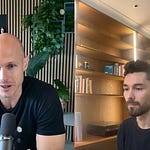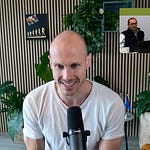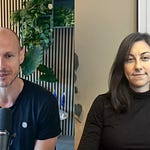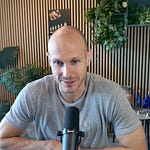Editor’s Note – Andreas Munk Holm, co-founder of eu.vc
We've recently shared raw updates from an anonymous first-time manager’s diary, and you've loved it. Today, we bring you the reflections and learnings from a Fund II manager.
Fund II is a critical milestone—you're back tapping the shoulders of friends (and maybe a few institutions) who've supported you once already. Some expect your return; others may be less prepared. Now you're institutionalizing—not just your firm but also your LP base. You may not yet have DPI, but hopefully a few solid up rounds and early leading indicators of your promise--perhaps even an emerging brand. It's tough—so tough, in fact, that 9 out of 10 emerging firms never raise their next fund.
At EUVC, we're building a database to make fundraising a bit easier. One place to find them all💍. The conviction: there are GREAT managers starved for capital, and LPs in need of discovering compelling opportunities beyond their usual networks—if only finding each other was simpler. If you're a manager or LP, sign up for early access here.
Today’s diary entry is from the team at s16vc, who, after 30 months and 11 closes have managed to reach the coveted status of oversubscribed. There's some real learnings in there. Hope you’ll enjoy it.
Fund 2 is oversubscribed — reflections on the journey
Happy to report we have hit our Fund 2 target of $64m in commitments, and expect our final close to reach the hard cap of $70m. When we set out to fundraise in early 2022, the world was much different. Miro has just completed a blockbuster Series C, ChatGPT hasn’t launched, and the markets were still riding the last wave of ZIRP high. We were buoyed by the support received from our existing Fund 1 LPs, institutional backers, and the broader core of S16 community to complete a $28m first close in Sep-22.
From then on, the going got much tougher. The markets have turned, and as VC winter has settled in, risk appetite vanished, especially for a long-term, illiquid proposition like a venture fund. On top of that, we were a new kid on the block, an emerging manager with no DPI to brandish and an unproven community fund business model that didn’t fit squarely into the usual boxes of generalist / specialist VC. To make matters worse, our main investor audience — tech founders — were feeling the crunch themselves, and had plenty of other problems to deal with than consider new commitments. Many were laying off teams and trimming personal budgets.
Over time we realized that the success of our first close was the result of the relationships & reputation we have built over the previous decade. The people who backed us then knew us well for many years before we came asking for the money. As far as the rest of the market was concerned, we were a fledging start-up with unclear prospects — and we weren’t alone in that predicament. Stats we have seen point out that only 12% of emerging managers were able to raise their next funds in the last few years, which means 9 out of 10 new VC firms were wiped out during this time.
We have also learned that raising for the fund is more difficult than raising for a start-up. A start-up has a clearly defined market, problem, and solution, and a clear thesis around how it will go about making money — the fund lacks all that certainty. Even more importantly, a start-up’s fundraise usually has a clear end in sight, and processes rarely take more than a quarter. For a fund, the ultimate deadline is your legal final close deadline. There is almost no incentive to invest early. As one established manager astutely pointed out to us “You have to sell the last million a hundred times.” The challenge is to do that while maintaining integrity and trust.
Our original plan was to raise $64m within 12 months after first close. From the outset, we suspected this could be a stretch, and made a prescient call to extend our investment period to 5 years from the standard 4 years, to have enough time to deploy capital raised in subsequent closings. We also had the right hunch that start-up valuations would adjust to the new world of high interest rates with a lag, so it made sense to preserve the drypowder for later in the fund lifecycle to join deals at more attractive valuations.
In the end, our fundraising journey took almost 30 months and 11 separate closes — and required one extension beyond the initially agreed period, for which we are eternally grateful to our LP community.
My entire professional career, I’ve been an investor, or as we used to say at Goldman Sachs, capital allocator. Needless to say, allocating capital and raising capital are two wildly different jobs. Having survived the VC winter, which has now thawed into VC spring, I’d like to share a few words of advice to friends & colleagues who are in the business of raising capital:
Trust the compounding. I like to remind myself that compounding is one of the greatest forces in the universe. In the beginning, you have nothing but a dream to sell, along with your pretty eyes. Over time, proofpoints will emerge — in our case, a robust portfolio of strong companies with numerous uprounds, and the backing of more and more big names. Be sure to update your audience regularly on your progress.
Be sure to share not just your wins, but your failings too. People value authenticity and transparency. In the investing business, being real counts as much as being successful. When people hear of your failings, they will give much more benefit of the doubt for when you claim the wins.
Find your angle — differentiation is the key. For us, that means building a fund as a product—one that leverages community to create value for both our LPs and portfolio founders. We try to help our founder LPs be better angels investors. For more professional investors, we offer immersing them into the exciting & quirky world of tech founders via our community. For our portfolio founders, we try to live up to our motto: “We treat every founder request as our own” via our s16vc API platform. At the same time, our community-driven approach gives us access to unique deal flow from our founder network.
Be ok that most people will not buy into it from the start. At first, rejection will hurt — do not shy away from feeling the pinch. Over time, you will grow accustomed to it, and that’s when the tide will turn. And get used to sounding like a broken record. It may take up to 10 touchpoints for the “aha” moment.
Embrace variance. We’ve had multi-million commits come in after a single e-mail or Zoom call. In other cases, we’ve been told “No” after years of effort. In still others, these years of effort paid off, and we eventually got to a “Yes”. There is not one size that fits all. We’ve had strong quarters that pulled in up to $7m, followed by completely dry spells, even as our performance improved. This is part of the game.
Get used to ghosting. Many people are as uncomfortable to reject someone as to be rejected themselves. It seems wired in human nature — and it’s not about you, it’s about them. When ghosted, be sure to take a break and focus elsewhere, but then come back with an update, sending a signal you don’t hold grudges. People love resuming communication, especially as their moods and circumstances change.
No is not the same as never — find ways to stay in touch while avoiding transactionality. Trust takes time to grow. Our community model revolves around intimate, home-style events that create precious moments to build affinity and camaraderie. Our newsletter and chat groups are a way to scale this connectivity further. We like to say that with a typical fund, once you commit, you can expect to hear back from them once a quarter with a staid review. With us, your journey in the s16 world only begins.
Pay forward. Let people become part of your ecosystem to help them build conviction. Think of it as a long period of dating before sealing the deal. In our case, it’s about inviting people to join our deals, attend our events, and even become a part of our signature deal-sharing product, Orbit.
Beware party commits. You meet someone at a big event, and they love what you do. After a few glasses of wine, you’re vibing, and it seems like a match made in heaven. They commit on the spot, and you are elated that you’ve finally caught a break. You follow up in a week or so to check in, and they loop someone else into the chain, ostensibly for a technical sign-off — maybe their manager, a partner, or a lawyer. In reality, your new crush is having a severe case of buyers’ remorse, and the job of that other person is to just say “No” (preceded by some strategic ghosting).
Keep your house in order. For an extended fundraising, your CRM should be squeaky clean. You are guaranteed to forget who you’ve spoken to and when. Remember that you’re in an enterprise sales job.
Just keep at it. After 3 years, 11 closes, and over 400 conversations, when I look back at the growth in our AUM chart, it’s fair to say that the most important thing is persistence. I wouldn’t trade the experience of fundraising in a VC winter for anything, as it’s an invaluable exercise in Stoicism.
Watch the episode with the s16vc guys below 👀 or add it to your episodes on Apple or Spotify 🎧










